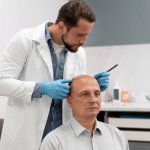Hair Transplantation for Androgenic Alopecia in Women
Hair loss, mainly androgenic alopecia (AGA), is often associated with men, but it also affects a significant number of women. Androgenic alopecia in women, also known as female pattern hair loss (FPHL), manifests as a diffuse thinning of hair over the scalp. While hair transplantation is commonly performed for men, its application in women, especially for androgenic alopecia, has become increasingly viable due to advances in surgical techniques. This brief provides an overview of androgenic alopecia in women, explores the role of hair transplantation as a treatment, and highlights the benefits, risks, and considerations specific to women.
1) Understanding Androgenic Alopecia in Women
- What is Androgenic Alopecia?
Androgenic alopecia is a hereditary form of hair loss caused by the effects of androgens, which are male hormones present in both men and women. In women, androgenic alopecia leads to progressive hair thinning in a diffuse pattern, primarily affecting the top of the scalp. Unlike men, women typically retain their hairline, but the density and volume of hair are reduced.
- Causes of Androgenic Alopecia in Women
- Hormonal Changes: Changes in hormonal levels, significantly decreased estrogen during menopause, play a significant role in female pattern hair loss.
- Genetics: Genetics is the primary factor, with the condition being inherited from either parent.
- Other Factors: Stress, nutrition, certain medications, and underlying medical conditions such as polycystic ovary syndrome (PCOS) can exacerbate androgenic alopecia.
- Symptoms
- Diffuse thinning on the top and crown of the scalp.
- Hair thinning in a “Christmas tree” pattern, often widening at the parting.
- Hair miniaturization, where the hair becomes finer and shorter.
2) Hair Transplantation as a Treatment for Androgenic Alopecia
Hair transplantation is a surgical procedure that involves moving hair follicles from one part of the scalp (usually the back and sides, called the “donor area”) to thinning or balding areas (the “recipient area”). In women with androgenic alopecia, this can help restore hair density and create a more aesthetically pleasing look.
- Who is a Good Candidate?
Not all women with androgenic alopecia are suitable candidates for hair transplantation. Several factors must be considered:
- Stable Hair Loss: Candidates should have stabilized hair loss. If the hair is still rapidly thinning, a hair transplant might not be appropriate since transplanted hair may not blend well with the continuing loss.
- Sufficient Donor Hair: Unlike men, who typically have a stable donor area (the back and sides of the scalp), women with diffuse thinning may also experience hair loss in these areas. Therefore, women must have enough healthy hair follicles in the donor area for a successful transplant.
- Localized Hair Loss: Hair transplantation is more effective in areas of localized hair loss rather than diffuse thinning over the entire scalp.
- Realistic Expectations: Women need realistic expectations about the results. Hair transplantation does not necessarily restore the hair to its original thickness but can improve the overall appearance by increasing hair density.
- Hair Transplant Techniques
There are primarily three hair transplant techniques for hair loss treatment:
- Direct Hair Implantation (DHITM): This method of hair transplantation is non-invasive and involves extracting hair follicles from a donor area and implanting them directly into the recipient area without creating incisions or channels beforehand. The process is performed using a specialized tool called a DHI Implanter, which allows precise control over each implanted follicle’s angle, direction, and depth, giving lifetime visible results.
- Follicular Unit Extraction (FUE): This method involves individually extracting hair follicles from the donor area with an extractor, collecting all the grafts in a tray, and then creating slits with the help of a sharp blade into the recipient area and then transplanting them via inserting grafts with forceps to the recipient site.
- Follicular Unit Transplantation (FUT): This technique involves removing a strip of scalp from the donor area, from which individual follicular units are extracted and transplanted. FUT tends to be more efficient regarding the number of grafts that can be transplanted in one session, but it leaves a linear scar, which may be a concern for women who wear their hair short or thin.
- Procedure Overview
- Consultation: The process begins with a thorough consultation to determine if the patient is suitable for a hair transplant. The surgeon assesses the extent of hair loss, the quality of the donor’s hair, and the patient’s expectations.
- Preparation: On the day of the procedure, the donor area is shaved, and local anesthesia is applied to minimize discomfort. The patient remains awake during the procedure. Only in the DHITM—Direct Hair Implantation technique—are two options available: shaven and unshaven hair transplant treatment.
- Harvesting: In the most advanced DHITM Direct hair implantation technique, each follicle or graft is extracted by a unique motorized extractor. In the FUE method, individual follicles are extracted individually. In FUT, a strip of scalp is removed, and the follicles are isolated. The donor hair is usually taken from the back of the scalp, where hair is more resistant to the effects of androgens.
- Implantation: In the DHITM Direct hair implantation technique, each follicle is placed directly with the help of the most advanced implantor, which privileges the surgeon. The follicles are placed at the correct angle, direction, and depth, committed to natural results with maximum density. In DHITM clinics, only surgeons performed surgery; no assistant technician or nurse touched the patient’s scalp during surgery.
In the FUE technique, the technician creates small incisions in the recipient area and carefully places the grafts using forceps to align with the natural direction of the patient’s hair.
- Post-Procedure Care: After the transplant, patients are instructed on aftercare, including washing the hair gently and avoiding activities that could disturb the grafts. Some swelling and mild discomfort may occur, but this typically resolves within a few days.
- Expected Results
- Initial Shedding: Transplanted hair may fall out within the first few weeks, a normal part of the process known as “shock loss.” After a few months, new hair starts to grow.
- Final Results: Full results become visible after 9-12 months, with natural-looking hair growth and improved density in the transplanted areas.
3) Benefits of Hair Transplantation for Androgenic Alopecia in Women
- Permanent Solution: Unlike other treatments, such as topical or oral medications, hair transplantation offers a permanent solution to hair loss.
- Natural-Looking Results: Modern transplantation techniques, particularly DHITM, allow for natural results, with transplanted hair growing and behaving like natural hair.
- Improved Confidence: Many women suffering from androgenic alopecia experience a significant boost in confidence and self-esteem following a successful hair transplant, as the visible signs of thinning hair can be distressing.
- Low Maintenance: Once the transplanted hair has grown, it requires no special maintenance and can be treated like the rest of the patient’s natural hair.
4) Risks and Considerations
While hair transplantation can be an effective treatment for androgenic alopecia in women, it is not without its risks and considerations.
- Risks
- Shock Loss: Some transplanted hair may fall out in the weeks following surgery, although this is typically temporary.
- Infection or Scarring: Although rare, there is a risk of infection or noticeable scarring, especially with the DHITM method. Choosing an experienced surgeon and the most advanced hair transplant techniques reduces these risks.
- Unsuccessful Transplantation: In some cases, the transplanted hair may not grow as expected, or the results may not meet the patient’s expectations. This can be particularly problematic in women with diffuse thinning, where the donor hair may not be of sufficient quality.
- Hairline Irregularities: Achieving a natural-looking hairline in women can be more challenging than in men, as women tend to retain their hairline, but the density may be uneven. Poor placement of the grafts can result in an unnatural appearance. However choosing the most advanced hair transplant technique doesn’t perform these irregularities.
- Considerations
- Cost: Hair transplantation is a little expensive, but it transforms lives; hence, it is not expensive compared to the full happiness and youth experience a candidate feels. It often costs several thousand, depending on the number of follicles or grafts required and the surgeon’s expertise. Health insurance may not cover the cost as it is a cosmetic procedure.
- Ongoing Hair Loss: Hair transplantation does not stop the progression of androgenic alopecia. Therefore, women may continue to lose hair in untreated areas, necessitating additional treatments.
- Combination with Other Treatments: Many women combine hair transplantation with other treatments for androgenic alopecia, such as minoxidil (a topical solution) or low-level laser therapy (LLLT), to enhance and maintain results.
- Patient Expectations: Women must have realistic expectations about what a hair transplant can achieve. While it can restore density and improve appearance, it does not completely restore the original thickness of hair. Moreover, the final results take time to become fully visible. However, in the DHITM system, patient satisfaction rates are 99.9%.
In Conclusion
Hair transplantation for women with androgenic alopecia offers a viable solution to thinning hair and improving appearance and confidence. However, it is not suitable for everyone, and the procedure requires careful consideration of factors such as the stability of hair loss, the quality of the donor area, and the patient’s overall expectations. While hair transplantation is a permanent solution, it does not stop the progression of androgenic alopecia, and women may need ongoing treatments to maintain their results. By consulting with an experienced surgeon and following the appropriate pre-and post-operative care, women can achieve satisfying, natural-looking outcomes that address hair loss’s cosmetic and emotional impacts.






